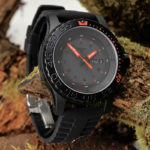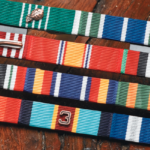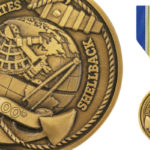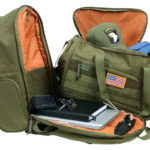For over 80 years, the United States military has awarded soldiers who display “exemplary conduct, efficiency, and fidelity” with the Good Conduct Medal. When soldiers have earned more than one Good Conduct Medal, they can display those multiple bestowals with an Army Good Conduct Medal (AGCM) knot.
Various Army Good Conduct Medal knots are awarded for a certain number of Good Conduct Medals. While they may look relatively similar, there can be quite a significant distinction between different military knots.
To help you understand those distinctions and better grasp the history and importance of the Good Conduct Medal and Army knots, we’ve created this guide with everything you need to know.
History of Army Knots for Good Conduct
Although the Army’s Good Conduct medal hasn’t been around all that long relative to the United States Army’s history, the medal is among the oldest of all American military awards.
The United States Navy has been awarding active-duty enlisted members the Good Conduct Medal for over 150 years after establishing the award in April 1869.
The original criteria for receiving a U.S. Navy Good Conduct Medal (NGCM) was that the recipient must display “obedience, sobriety, and cleanliness” or great proficiency in “gunnery and seamanship.” While all those qualifications still factor in, the criteria have expanded significantly.
The Marine Corps was the second military branch to adopt the Good Conduct Medal (CGGCM) in July 1896, and the Coast Guard became the third in May 1921. The base requirement for these awards was that the recipient display exemplary conduct over three consecutive years of service.
Army Good Conduct Medal Knots
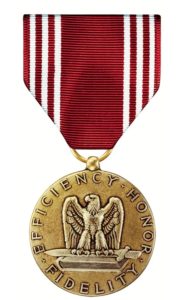 It wasn’t until World War II, over 70 years after the U.S. Navy began awarding the Good Conduct Medal, that the U.S. Army created its version.
It wasn’t until World War II, over 70 years after the U.S. Navy began awarding the Good Conduct Medal, that the U.S. Army created its version.
President Franklin D. Roosevelt signed Executive Order 8809 in June of 1941, which ordered the creation of the medal. Subsequent executive orders amended that order to define all award recipients’ criteria further.
The Army Good Conduct Medal has a red ribbon with six white stripes. The medal’s reverse reads “For Good Conduct,” with a five-pointed star and a banner in the center. The medal itself is bronze, and it displays an eagle clutching a Roman sword atop a book with the words “Efficiency,” “Honor,” and “Fidelity” around the perimeter.
Army knots were created at the same time that the Good Conduct Medal was. Their design consolidates multiple Good Conduct Medals into a smaller and more easily displayed award device.
The material with which the good conduct medal knots are made, and the number of military knots displayed to indicate a certain number of medals awarded.
Qualifications for Army Knots
The U.S. Army defines the criteria for receiving the Good Conduct Medal as follows:
“It is awarded for exemplary behavior, efficiency, and fidelity in active Federal military service … on a selective basis to each soldier who distinguishes himself or herself from among his or her fellow soldiers by their exemplary conduct, efficiency, and fidelity throughout a specified period of continuous enlisted active Federal military service.”
The U.S. Army also describes recipients of the award as having carried out three consecutive years of “honorable and faithful service,” which means that a recipient has conducted themselves in a manner that did not require non-judicial punishments. The recipient must not have received disciplinary infractions or committed acts regarded as court-martial offenses.
The period of service over which the criteria must be met is three years completed after August 27, 1940, or after completing at least one year of service if separated before three years. Individuals who died in the line of duty before completing one year of service are also eligible for the award.
Good Conduct Medal Knots Devices
Now that you know the history of the Good Conduct Medal and military knots, it’s time to look at the actual award devices used to represent the honor bestowed upon the service member who has earned one or more Good Conduct Medals.
What Knots Look Like
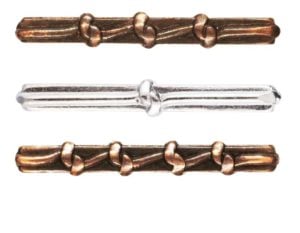 Military knots are also known as “loops,” and the knots on the award device can be referred to as “hitches.” They are rectangular clasps of bronze, silver, or gold that can contain between one and five knots.
Military knots are also known as “loops,” and the knots on the award device can be referred to as “hitches.” They are rectangular clasps of bronze, silver, or gold that can contain between one and five knots.
One knot represents one Good Conduct Medal, a silver clasp represents five medals, and a gold clasp represents ten.
Where to Place Military Knots on a Uniform
Good Conduct Medal knots are worn on top of the good conduct medal itself. The clasp is attached to the medal and ribbon to denote multiple medals, rather than displaying numerous medals on the uniform.
Proper placement of the Good Conduct Medal and Army knots is below the area where a Prisoner of War Medal should be displayed and above the area where an Army Reserve Good Conduct Medal should be displayed.
What Each Knot Means
As stated earlier, military knot devices don’t look all that different — but there can be quite a large gulf between the two, and it’s essential to know the difference.
The bronze military knot device is the first Army knot you will be able to wear should you earn more than one Good Conduct Medal. They can contain between two and five knots, each denoting a Good Conduct Medal received.
A single silver military knot device contains only one hitch, but it represents six medals earned. Think of the silver device as representing five medals, then add up the number of hitches, which can be between one and five, and you have the number of Good Conduct Medals received.
A single gold military knot device represents ten Good Conduct Medals earned. They can display between one and five knots, which means that they can represent anywhere from 11 to 15 Good Conduct medals.
Want to learn more about military medals, awards, and more? Sign up for emails from Medals of America today.


